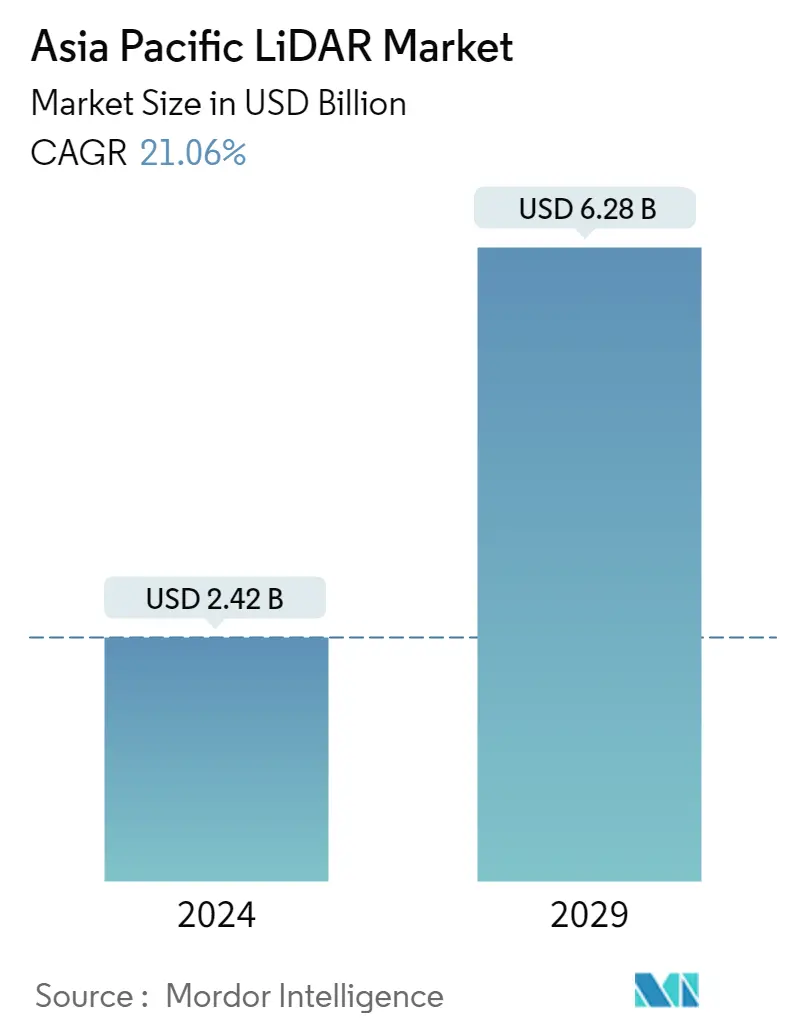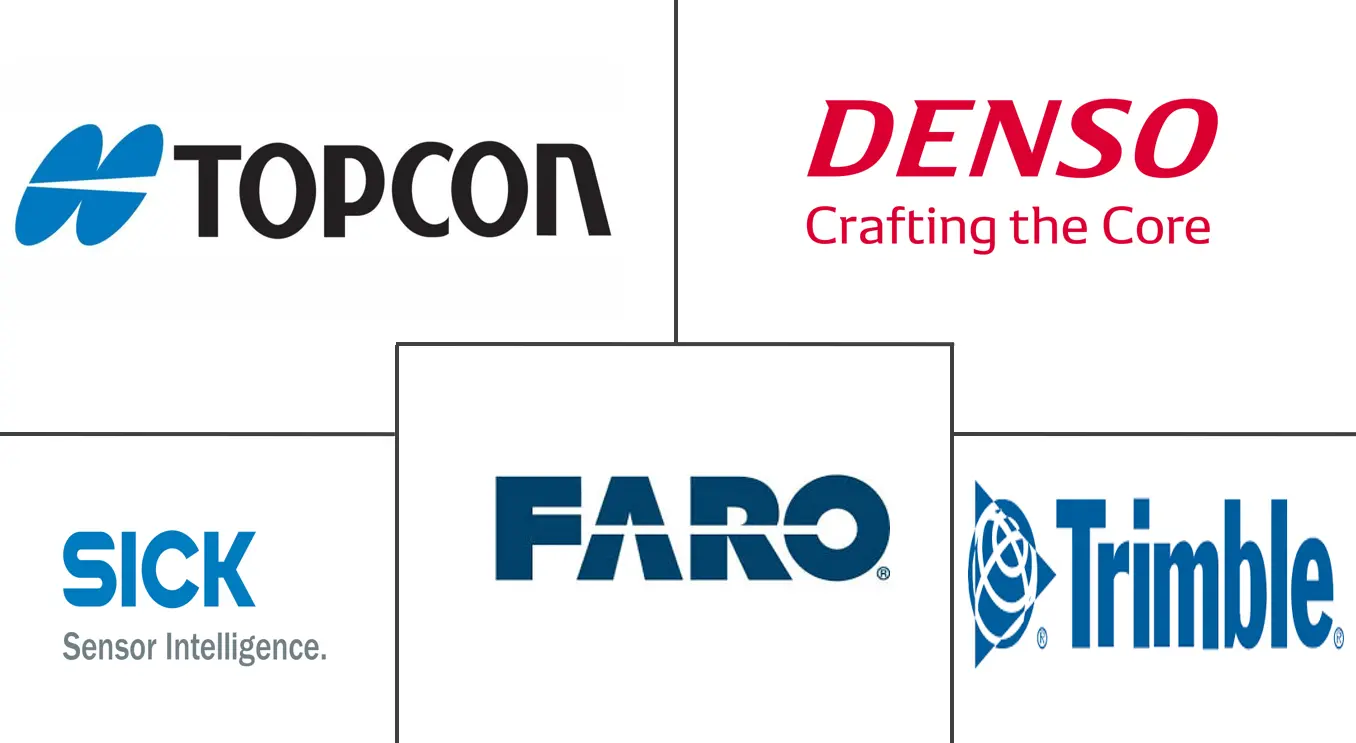Market Size of Asia Pacific LiDAR Industry

| Study Period | 2019 - 2029 |
| Base Year For Estimation | 2023 |
| Market Size (2024) | USD 2.42 Billion |
| Market Size (2029) | USD 6.28 Billion |
| CAGR (2024 - 2029) | 21.06 % |
| Market Concentration | Low |
Major Players
*Disclaimer: Major Players sorted in no particular order |
APAC LiDAR Market Analysis
The Asia Pacific LiDAR Market size is estimated at USD 2.42 billion in 2024, and is expected to reach USD 6.28 billion by 2029, growing at a CAGR of 21.06% during the forecast period (2024-2029).
LiDAR-based mapping solutions are agile and can be used on a stationary or moving vehicle. Owing to this, they are being adopted by a growing number of industries, especially for application in engineering, construction, environment, and exploration, proving the effectiveness and, therefore, demand for this technology.
- These LiDARs are also used for the planning of field campaigns and mapping under the forest canopy. Spain-based scientists improved the annual and seasonal mapping accuracy with LiDAR data (from 73% to 83%). Moreover, another major driving factor for the LiDAR market is the increasing use of drones for multiple applications, such as aerospace and defense and automation, which are leading organizations to invest in drone research.
- In this region, LiDAR system applications are also being deployed in defense, geological surveys, pollution monitoring, transport, energy, and construction sectors, coupled with drones. Additionally, countries such as India and China are expected to increase, speeding an average of USD 7 billion in drone technology for defense in the forecast period.
- In Malaysia, the government has been using LiDAR to map the water table depth, flood risk in coastal areas, and canal-blocking restoration requirements. The increase in such adoption of LiDAR systems by governments across different countries in the region is expected to positively contribute to the market's growth over the forecast period.
- Japan's Mitsubishi Electric Corporation unveiled a new compact LiDAR solution for autonomous vehicles, equipped with MEMS that can enhance the horizontal vision span and pedestrian detection capabilities of the self-driving vehicle, with a volume of around 900cc. The company is also planning to develop a smaller LiDAR variant with a volume of just 350cc or less.
- Furthermore, the COVID-19 pandemic led to lockdowns all over the world. This disrupted the exports of automotive parts as well as the manufacturing process. Moreover, the expensive nature of the systems is challenging the adoption of these systems. Companies such as Ford and Baidu were investing in these systems to develop low-cost LiDAR systems.
APAC LiDAR Industry Segmentation
LiDAR systems are used to help scientists and mapping professionals examine both natural and artificial environments with precision, accuracy, and flexibility. Moreover, LiDAR is used for automated tractor steering solutions and surveying fields with drones in the agriculture industry.
The Asia-Pacific LiDAR market is segmented by product (aerial LiDAR and ground-based LiDAR), component (GPS, laser scanners, and inertial measurement unit), and end user (engineering, automotive, industrial, and aerospace and defense). The market sizes and forecasts are provided in terms of value (USD) for all the above segments.
| Product | |
| Aerial LiDAR | |
| Ground-based LiDAR |
| Components | |
| GPS | |
| Laser Scanners | |
| Inertial Measurement Unit | |
| Other Components |
| End User | |
| Engineering | |
| Automotive | |
| Industrial | |
| Aerospace and Defense |
Asia Pacific LiDAR Market Size Summary
The Asia Pacific LiDAR market is poised for significant growth, driven by the increasing adoption of LiDAR-based mapping solutions across various industries such as engineering, construction, and environmental monitoring. The technology's versatility, allowing for use on both stationary and moving vehicles, has led to its widespread application in sectors like defense, geological surveys, and pollution monitoring. The integration of drones with LiDAR systems further enhances their utility, particularly in aerospace, defense, and automation applications. Governments in countries like Malaysia, India, and China are actively utilizing LiDAR for projects ranging from flood risk assessment to drone technology investments, which are expected to bolster market expansion. The automotive sector is also emerging as a key area for mobile ground-based LiDAR systems, supported by government initiatives mandating advanced driver-assistance systems.
The market is characterized by intense competition, with major players investing heavily in research and development to differentiate their offerings. Innovations such as Mitsubishi Electric's compact LiDAR solution for autonomous vehicles and Toshiba Corporation's advancements in object tracking accuracy highlight the ongoing technological advancements in the region. Partnerships, like those between EcoTech Ltd. and YellowScan, are expanding the application of LiDAR in ecological monitoring and surveying. Despite challenges such as high costs and regulatory hurdles, the market's growth is supported by the increasing demand for high-resolution mapping and real-time data analysis capabilities, which LiDAR technology provides.
Asia Pacific LiDAR Market Size - Table of Contents
-
1. MARKET INSIGHTS
-
1.1 Industry Attractiveness - Porter's Five Forces Analysis
-
1.1.1 Threat of New Entrants
-
1.1.2 Bargaining Power of Buyers
-
1.1.3 Bargaining Power of Suppliers
-
1.1.4 Threat of Substitute Products
-
1.1.5 Intensity of Competitive Rivalry
-
-
1.2 Industry Value Chain Analysis
-
1.3 Impact of COVID-19 on the Market
-
-
2. MARKET SEGMENTATION
-
2.1 Product
-
2.1.1 Aerial LiDAR
-
2.1.2 Ground-based LiDAR
-
-
2.2 Components
-
2.2.1 GPS
-
2.2.2 Laser Scanners
-
2.2.3 Inertial Measurement Unit
-
2.2.4 Other Components
-
-
2.3 End User
-
2.3.1 Engineering
-
2.3.2 Automotive
-
2.3.3 Industrial
-
2.3.4 Aerospace and Defense
-
-
Asia Pacific LiDAR Market Size FAQs
How big is the Asia Pacific LiDAR Market?
The Asia Pacific LiDAR Market size is expected to reach USD 2.42 billion in 2024 and grow at a CAGR of 21.06% to reach USD 6.28 billion by 2029.
What is the current Asia Pacific LiDAR Market size?
In 2024, the Asia Pacific LiDAR Market size is expected to reach USD 2.42 billion.

